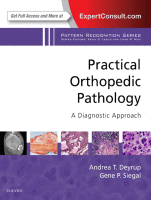Physical Address
304 North Cardinal St.
Dorchester Center, MA 02124

Many bone tumors contain large numbers of osteoclast-like giant cells. However, two lesions have many overlapping histologic findings and may pose a particularly difficult problem in differential diagnosis. These lesions are conventional giant cell tumor of bone and giant cell…

The vast majority (greater than 85%) of skeletal chondrosarcomas are conventional chondrosarcomas, which is a family constituted of primary central chondrosarcoma, primary peripheral chondrosarcoma, secondary central chondrosarcoma, secondary peripheral chondrosarcoma, and periosteal chondrosarcoma. The other entities to be considered in…

Chondroblastoma Definition and Synonyms Chondroblastoma is a benign cartilage-forming neoplasm occurring in the epiphyses of immature long bones. Brief Historical Overview Chondroblastoma was originally called a “calcifying giant cell tumor” by Ewing and “epiphyseal chondromatous giant-cell tumor” by Codman. In…

Juxtacortical lesions of bone are a group of entities with differing histogenesis and pathogenesis that arise in association with the periosteum. Periosteal stromal cells participate in fracture repair, and as such, they are able to differentiate into fibroblastic, osteoblastic, and…

Osteochondromas and Hereditary Multiple Osteochondroma Definition and Synonyms Osteochondroma, also known as exostosis or osteocartilaginous exostosis, is characterized by a cartilage-capped bony outgrowth containing a marrow cavity with continuity to the underlying bone. Historical Background Osteochondromas are the most common…

Osteosarcoma (also known as osteogenic sarcoma) includes lesions ranging from low grade and indolent to high grade and aggressive, but in all cases osteoid matrix is directly produced by neoplastic cells. Histologically diverse, it includes tumors that mimic giant cell…

Osteoma/Bone Island Definition and Synonyms Osteoma and bone island or enostosis are benign slow-growing non-neoplastic lesions composed of dense mature compact or cancellous bone. The basic difference between the two is their location—osteoma being a surface (parosteal, periosteal) lesion, whereas…

The diagnostic pathology of bones and joints is not significantly more complicated than the pathology of other body sites, but tissues that are essentially invisible to an examining physician and that then must be sawed and decalcified can be technically…

It is often said—only partly in jest—that orthopedic surgeons need to distinguish only two disease processes: fracture and degenerative arthritis. Although it is true that much of clinical orthopedic practice focuses more on the technical details of exactly what anatomy…

Solitary bone lesions and soft tissue masses are commonly encountered in general orthopedic practice. Emphasis in this chapter will be on the radiographic appearance of solitary bone lesions. However, advanced imaging patterns will also be discussed, especially in the setting…